Instructions to install NAS DS1621+ as a file server for businesses
Data is a valuable 'asset' that determines the success and development of most businesses, organizations or companies. However, problems related to data storage, security risks, and operating costs are always a dilemma for businesses.
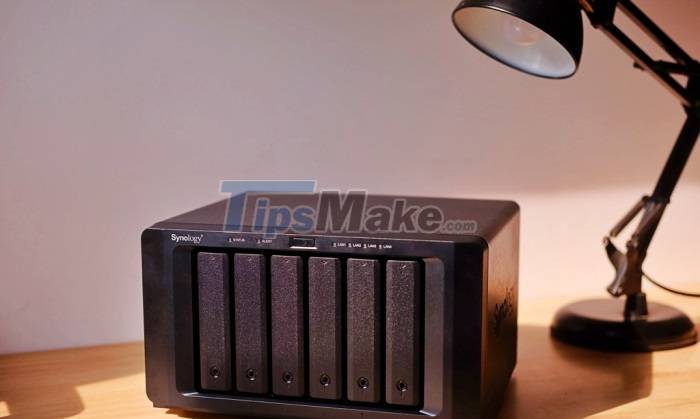 Instructions to install NAS DS1621+ as a file server for businesses Picture 1
Instructions to install NAS DS1621+ as a file server for businesses Picture 1
Usually, businesses will choose methods such as buying File Server from external service providers, hiring IT admin teams to operate them effectively. But now, businesses will not have to worry too much about that problem, the Synology server system is designed not only to provide easy access and data management in the internal network, but also for employees of the company. can be accessed remotely via Synology's FTP Service.
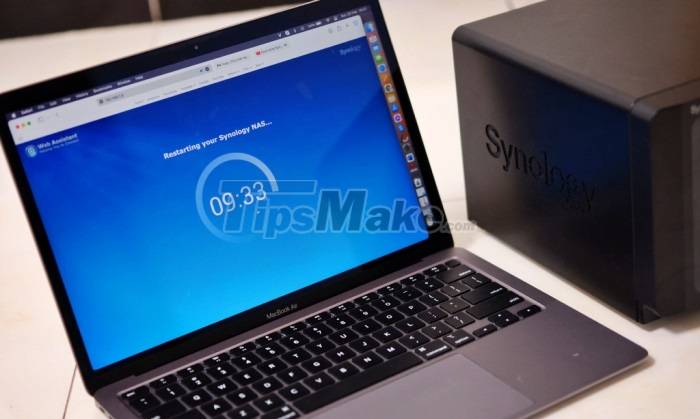 Instructions to install NAS DS1621+ as a file server for businesses Picture 2
Instructions to install NAS DS1621+ as a file server for businesses Picture 2
With simple setup, intuitive web interface easy to use, businesses can easily set up and manage the system efficiently. Especially, with Synology's DiskStation Manager (DSM) operating system with a huge application store optimized for web-based design, businesses can manage servers from anywhere with just a browser.
Instructions for creating Volume and choosing RAID on Synology NAS
For simplicity, you can understand Volume as the storage area on your Synology NAS device. All shared folders, documents or data packages will be stored on the volume. The first thing you need to do right after installing DSM is to create at least 1 volume to use.
Meanwhile, RAID (Redundant Array of Independent Disks) is a form of combining many physical hard drives into one hard drive system that has the function of increasing data read/write speed or to increase the safety of data. data stored on the disk system or a combination of the two.
Synology DiskStation supports many different types of raids, however, if you are not sure which raid to use or simply need DSM to arrange everything for you - SHR (Synology Hybrid RAID) technology will be the solution. you simplify the volume creation process while providing the flexibility that traditional RAID technology does not provide.
Here is the basic way you can create a volume from a hard drive.
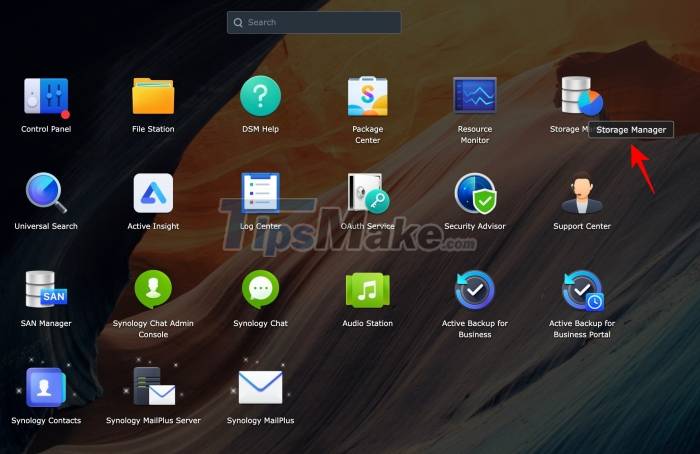 Instructions to install NAS DS1621+ as a file server for businesses Picture 3
Instructions to install NAS DS1621+ as a file server for businesses Picture 3
Step 1: Open Main Menu (left corner icon) > Select Storage Manager icon.
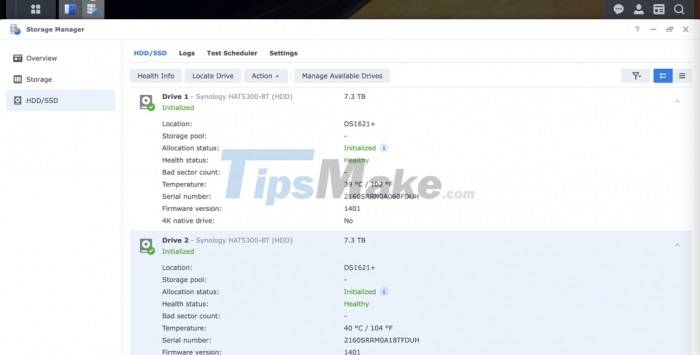 Instructions to install NAS DS1621+ as a file server for businesses Picture 4
Instructions to install NAS DS1621+ as a file server for businesses Picture 4
Step 2: In the HDD/SSD section, you can check the status of the hard drives being installed on the NAS. Currently TechZ is attaching 2 Synology HAT5300-8T hard drives with 8TB of memory.
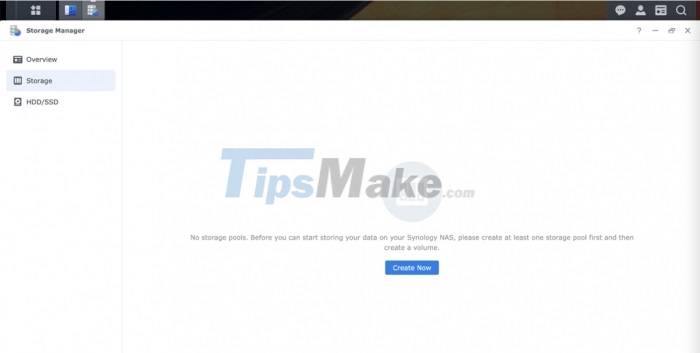 Instructions to install NAS DS1621+ as a file server for businesses Picture 5
Instructions to install NAS DS1621+ as a file server for businesses Picture 5
Step 3: Continue to click Storage > click Create Now to create a new Volume.
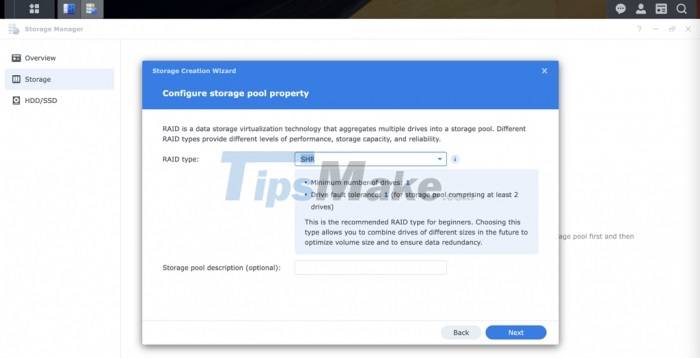 Instructions to install NAS DS1621+ as a file server for businesses Picture 6
Instructions to install NAS DS1621+ as a file server for businesses Picture 6
As mentioned above, you can choose the SHR (Synology Hybrid RAID) mechanism so that the DSM platform can calculate and come up with the best solution, ensuring data safety and increasing processing performance.
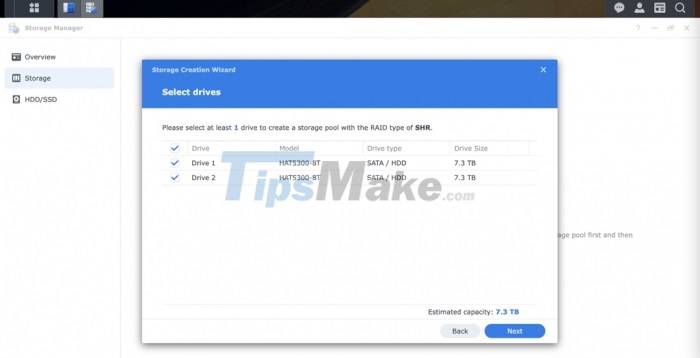 Instructions to install NAS DS1621+ as a file server for businesses Picture 7
Instructions to install NAS DS1621+ as a file server for businesses Picture 7
Step 4: Continue to click Next.
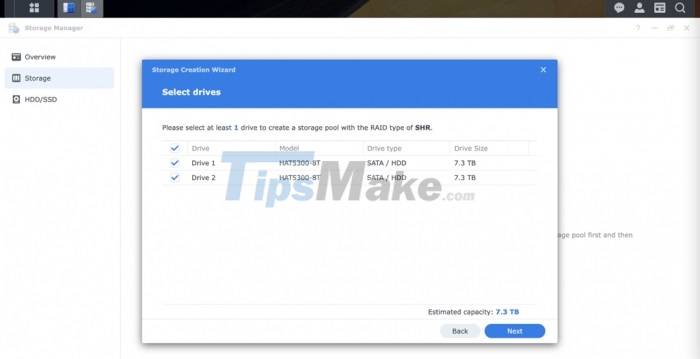 Instructions to install NAS DS1621+ as a file server for businesses Picture 8
Instructions to install NAS DS1621+ as a file server for businesses Picture 8
Step 5: Select the hard disks on which you want to create the volume.
Note that you must ensure that there is not any important data in the selected hard disks. Because those data will be deleted when the volume creation process takes place. A Warning message appears, select Yes to continue.
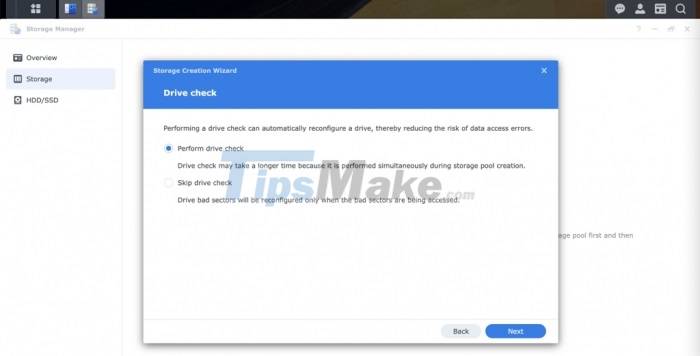 Instructions to install NAS DS1621+ as a file server for businesses Picture 9
Instructions to install NAS DS1621+ as a file server for businesses Picture 9
Step 6: At the Perform disk check section, continue to select Yes (Recommended) so that the system will automatically check the drive and remove the found bad sectors. Then you click Next.
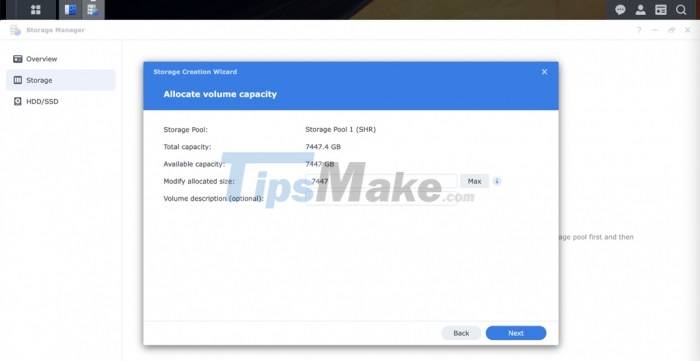 Instructions to install NAS DS1621+ as a file server for businesses Picture 10
Instructions to install NAS DS1621+ as a file server for businesses Picture 10
Step 7: At the Allocate volume capacity screen, you allocate the maximum capacity for the volume to be created. Depending on your needs, you will enter the desired amount of space in each volume. Here, I press the Max button to automatically enter the entire capacity of the hard drive.
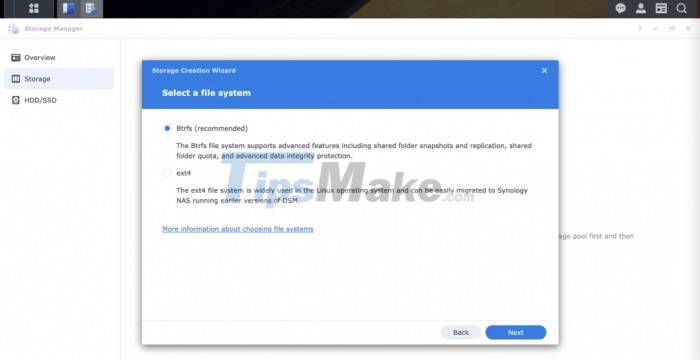 Instructions to install NAS DS1621+ as a file server for businesses Picture 11
Instructions to install NAS DS1621+ as a file server for businesses Picture 11
Step 8: At the file system selection screen, continue to select Btrfs to support advanced system features, including snapshots and replication, shared folder quota. TechZ will introduce these features more clearly. in the section below.
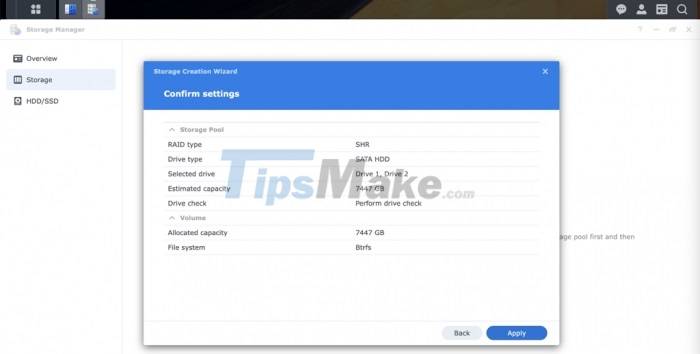 Instructions to install NAS DS1621+ as a file server for businesses Picture 12
Instructions to install NAS DS1621+ as a file server for businesses Picture 12
Step 9: At the final confirmation screen Confirm settings, select Apply to proceed with initializing the volume of the drive.
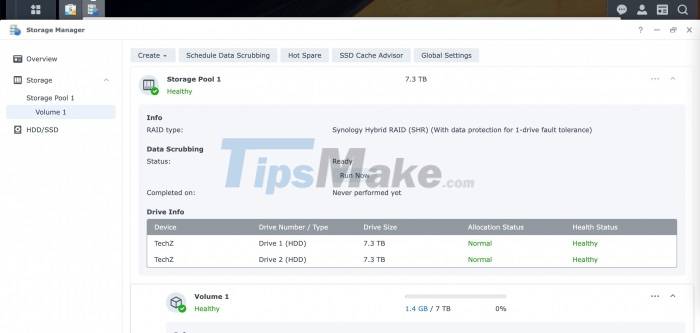 Instructions to install NAS DS1621+ as a file server for businesses Picture 13
Instructions to install NAS DS1621+ as a file server for businesses Picture 13
After the volume has successfully initialized, you must log in again to the system. Now you can proceed to work on that drive.
Quick Connect Installation Guide
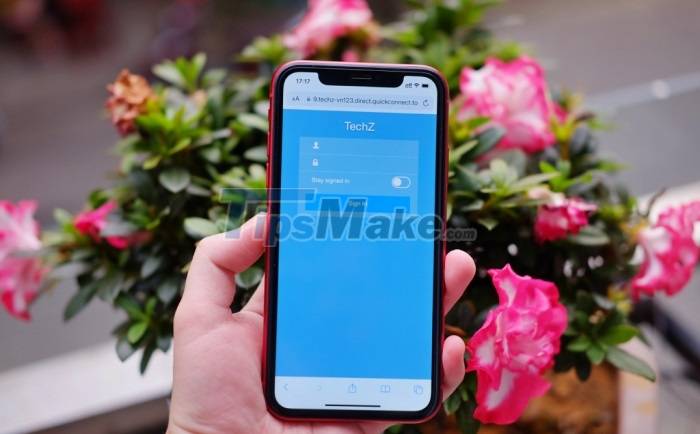 Instructions to install NAS DS1621+ as a file server for businesses Picture 14
Instructions to install NAS DS1621+ as a file server for businesses Picture 14
Quick Connect allows client applications to connect to your Synology NAS device over the internet easily, from anywhere.
To activate Quick Connect, follow the steps below:
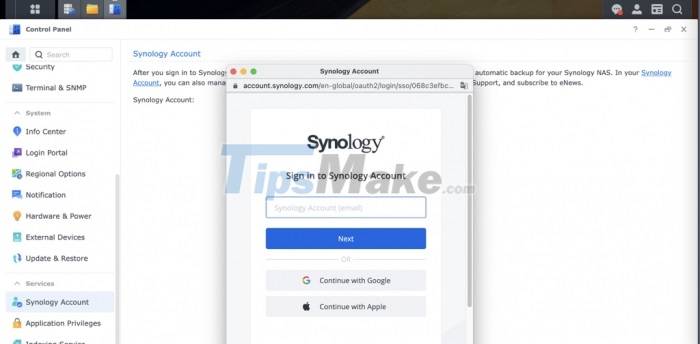 Instructions to install NAS DS1621+ as a file server for businesses Picture 15
Instructions to install NAS DS1621+ as a file server for businesses Picture 15
Step 1: Open Control Panel > Synology Account. Sign up and log in to your Synology account.
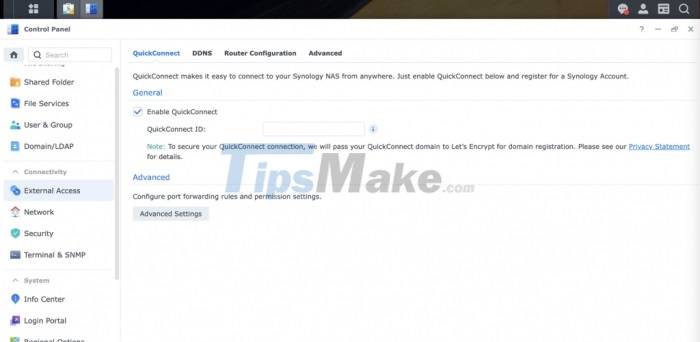 Instructions to install NAS DS1621+ as a file server for businesses Picture 16
Instructions to install NAS DS1621+ as a file server for businesses Picture 16
Step 2: At Control Panel > External Access > Click Enable QuickConnect.
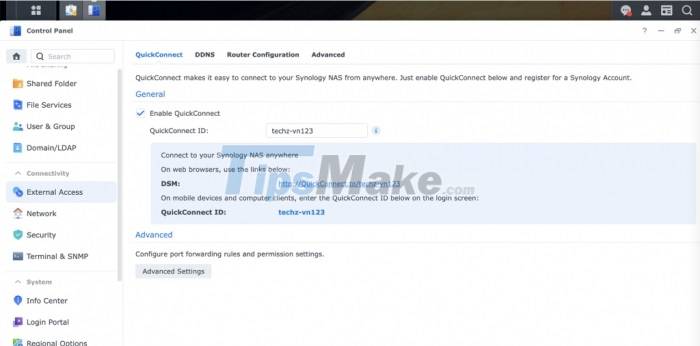 Instructions to install NAS DS1621+ as a file server for businesses Picture 17
Instructions to install NAS DS1621+ as a file server for businesses Picture 17
Step 3: Enter the QuickConnect ID, consisting of alphanumeric characters, and a dash (-) and must begin with a letter. (For example Techz-vn123).
Step 4: Click Apply.
Then, the DSM system will automatically register a QuickID for you and output a link. You will use this path to access the NAS from an external network with mobile devices, laptops.
Instructions for creating User & Group on Synology NAS devices
In order to avoid data loss and leakage to the outside, businesses are forced to create individual user accounts (User) or group (Group) so that NAS administrators can easily manage, monitor, limit minimize the serious risks that may happen to businesses and companies.
Group: Creating a Group helps businesses to group related employees together. For example, the editor group will include employees of the editor's office, the collaborator group will include employees working in the collaborator's room.
Step 1: Open Control Panel > Click on the User & Group icon.
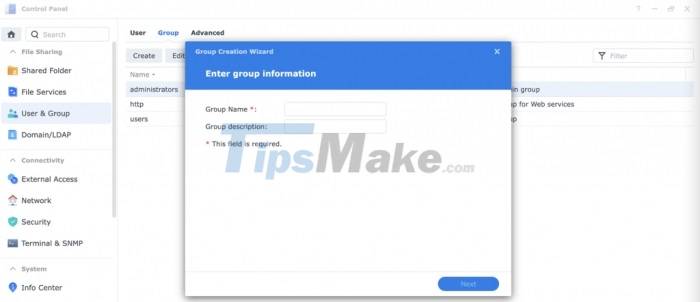 Instructions to install NAS DS1621+ as a file server for businesses Picture 18
Instructions to install NAS DS1621+ as a file server for businesses Picture 18
Step 2: Select Create.
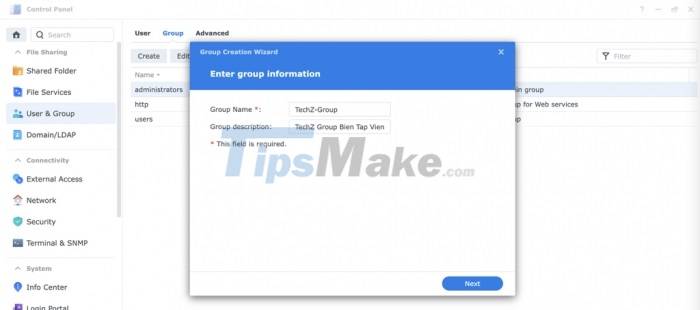 Instructions to install NAS DS1621+ as a file server for businesses Picture 19
Instructions to install NAS DS1621+ as a file server for businesses Picture 19
Step 3: Enter all the necessary information and click Next.
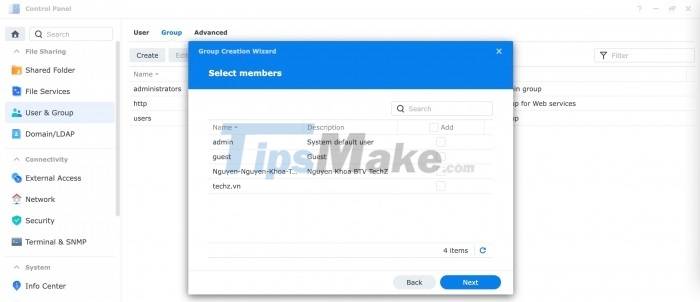 Instructions to install NAS DS1621+ as a file server for businesses Picture 20
Instructions to install NAS DS1621+ as a file server for businesses Picture 20
Step 4: Select the user to add to the group, if not, you can skip this step. Continue to click Next.
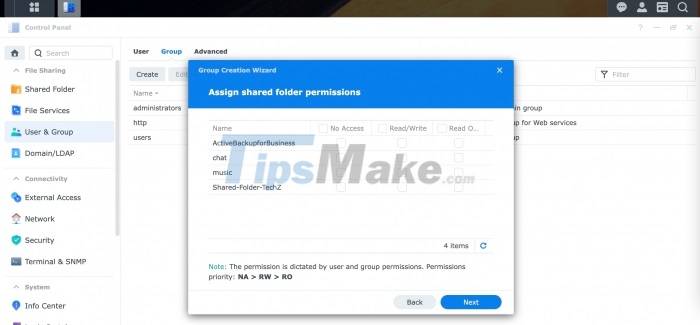 Instructions to install NAS DS1621+ as a file server for businesses Picture 21
Instructions to install NAS DS1621+ as a file server for businesses Picture 21
Step 5: Grant folder access to Group and click Next.
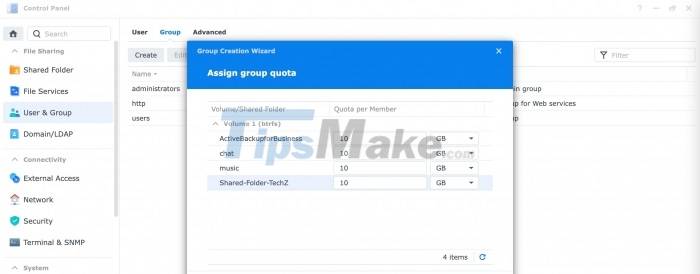 Instructions to install NAS DS1621+ as a file server for businesses Picture 22
Instructions to install NAS DS1621+ as a file server for businesses Picture 22
Step 6: Choose a space limit for each folder.
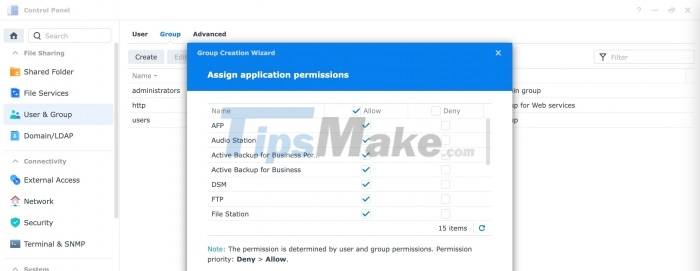 Instructions to install NAS DS1621+ as a file server for businesses Picture 23
Instructions to install NAS DS1621+ as a file server for businesses Picture 23
Step 7: Grant application access permission.
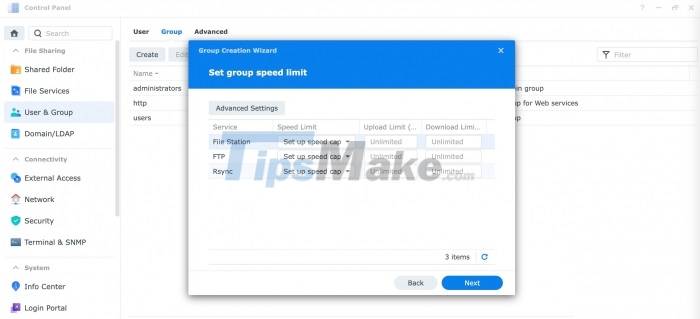 Instructions to install NAS DS1621+ as a file server for businesses Picture 24
Instructions to install NAS DS1621+ as a file server for businesses Picture 24
Step 8: Select Internet speed limit for each group.
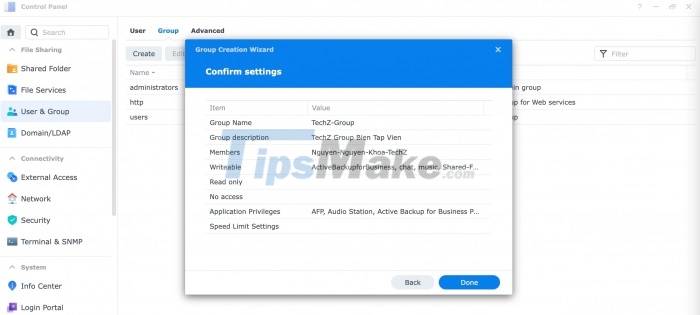 Instructions to install NAS DS1621+ as a file server for businesses Picture 25
Instructions to install NAS DS1621+ as a file server for businesses Picture 25
Step 9: At the Confirm Settings installation information confirmation screen, continue to click Done to complete the installation.
User: Next, businesses need to create accounts for employees.
Step 1: Open Control Panel > Click on the User icon
Step 2: Click Create
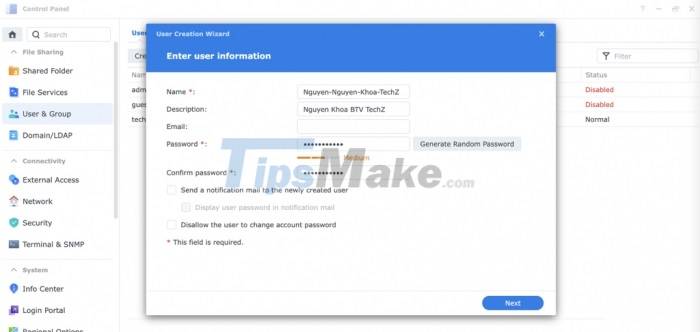 Instructions to install NAS DS1621+ as a file server for businesses Picture 26
Instructions to install NAS DS1621+ as a file server for businesses Picture 26
Step 3: Enter full User information and click Next.
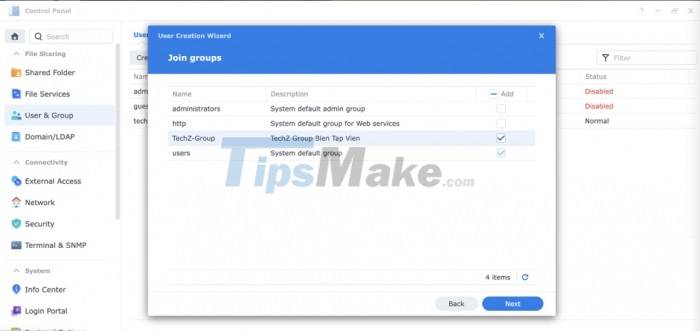 Instructions to install NAS DS1621+ as a file server for businesses Picture 27
Instructions to install NAS DS1621+ as a file server for businesses Picture 27
Step 4: In the Join Groups section, you can Join Users into existing groups, otherwise you continue to click Next.
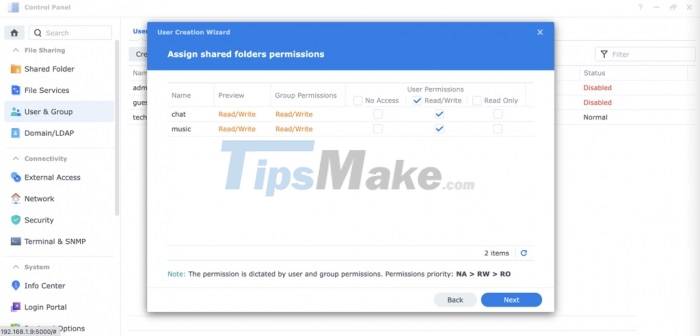 Instructions to install NAS DS1621+ as a file server for businesses Picture 28
Instructions to install NAS DS1621+ as a file server for businesses Picture 28
Step 5: Grant permission to use Folder for User.
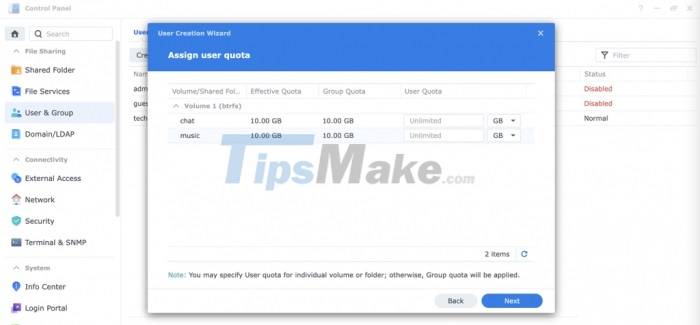 Instructions to install NAS DS1621+ as a file server for businesses Picture 29
Instructions to install NAS DS1621+ as a file server for businesses Picture 29
Step 6: You can limit the amount of space used for each user, then click Next.
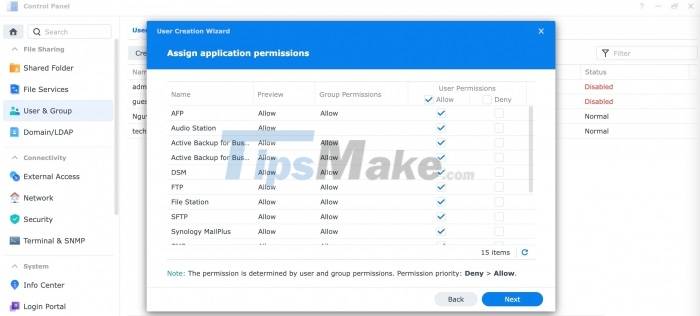 Instructions to install NAS DS1621+ as a file server for businesses Picture 30
Instructions to install NAS DS1621+ as a file server for businesses Picture 30
Step 7: Grant application access rights to the user.
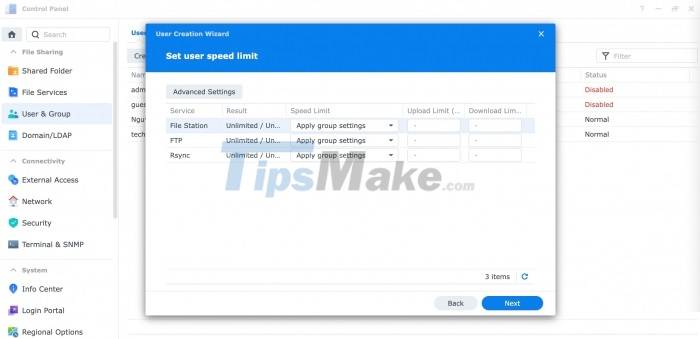 Instructions to install NAS DS1621+ as a file server for businesses Picture 31
Instructions to install NAS DS1621+ as a file server for businesses Picture 31
Step 8: Limit download and upload speeds for users.
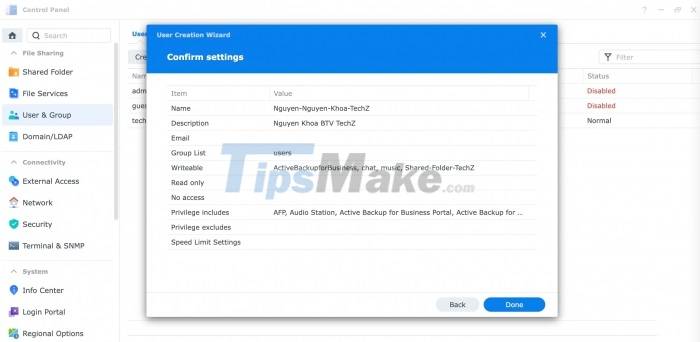 Instructions to install NAS DS1621+ as a file server for businesses Picture 32
Instructions to install NAS DS1621+ as a file server for businesses Picture 32
Step 9: At the Confirm Settings installation information confirmation screen, click Done to complete the installation.
Create folders and assign access permissions for Synology NAS
To help businesses keep their data secure. Synology NAS offers folder creation with access permissions, smart security features, easy sharing, and simple setup.
Step 1: Open Control Panel > Select Shared Folder and click Create Shared Folder.
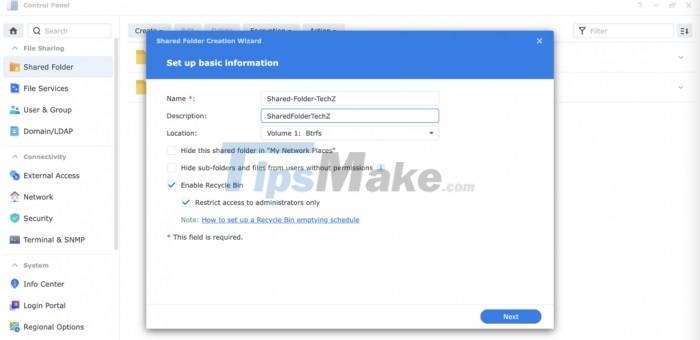 Instructions to install NAS DS1621+ as a file server for businesses Picture 33
Instructions to install NAS DS1621+ as a file server for businesses Picture 33
Step 2: Enter the necessary information in the Name & Description field.
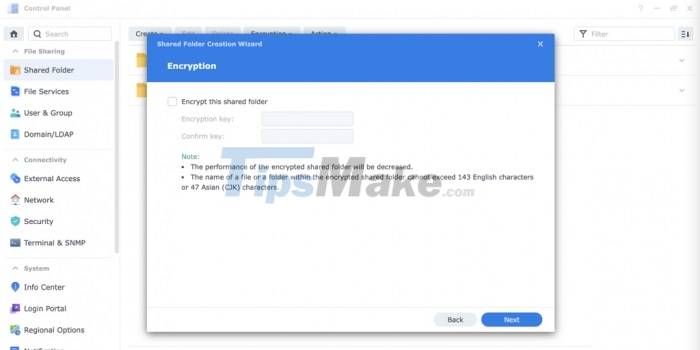 Instructions to install NAS DS1621+ as a file server for businesses Picture 34
Instructions to install NAS DS1621+ as a file server for businesses Picture 34
Step 3: Encrypt for Shared Folder.
Enable Encryption this Shared Folder by checking the box.
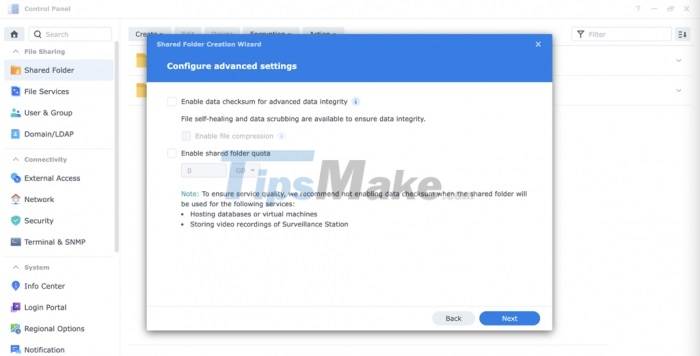 Instructions to install NAS DS1621+ as a file server for businesses Picture 35
Instructions to install NAS DS1621+ as a file server for businesses Picture 35
Step 4: Configure Advanced for Shared Folder.
Enable data checksum for advanced data integrity: To protect Shared Folder with CRC32 checksum and copy-on-write, you can enable data checksum to improve data integrity during Shared Folder creation. The CRC32 checksum when enabled checks that data is the same as when they were originally written, and the system uses RAID redundancy to repair damaged data. Copy-on-write helps to improve data consistency when the system is unexpectedly shut down.
Enable file compression: The data in the created Share Folder will be automatically compressed by the Btrfs file system to save storage space. When taking out and using, the data will be decompressed.
Enable shared folder quota: Limit the maximum size for each Shared Folder. Click Enable shared folder quota to enter the maximum size for the desired folder.
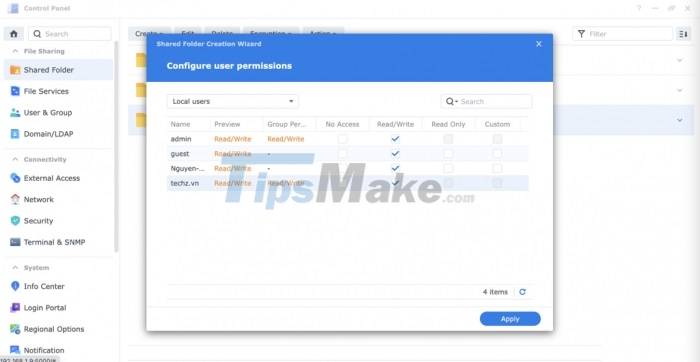 Instructions to install NAS DS1621+ as a file server for businesses Picture 36
Instructions to install NAS DS1621+ as a file server for businesses Picture 36
Step 5: Assign permissions for Shared Folder
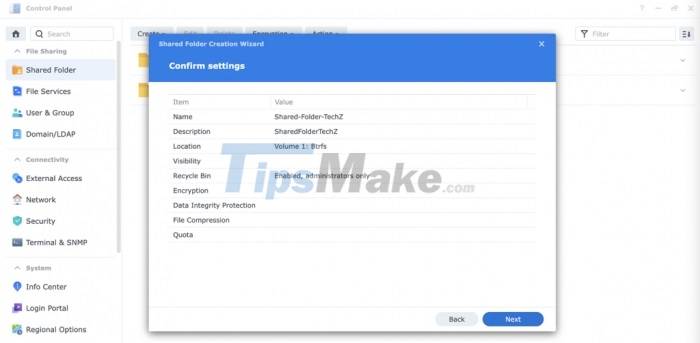 Instructions to install NAS DS1621+ as a file server for businesses Picture 37
Instructions to install NAS DS1621+ as a file server for businesses Picture 37
Step 6: At the screen to confirm the installation information - Confirmed Setting. Click Next to finish creating the Shared Folder.
Create access for SMB
Learn more about SMB (Server Message Block), which is a protocol that allows Windows, Mac, and Linux clients with SMB/CIFS support to access data stored on a Synology NAS. If you want to find files on your Synology NAS through Windows Explorer or mount Shared Folders as a network drive, follow the steps below:
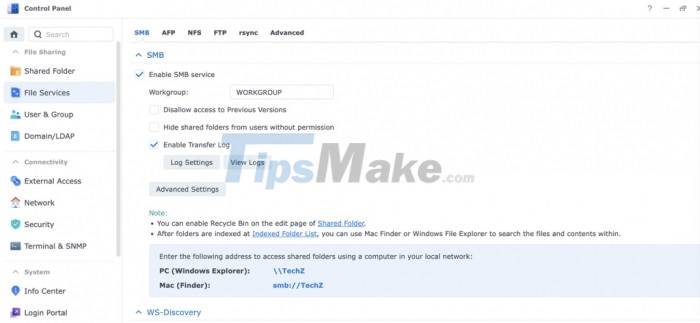 Instructions to install NAS DS1621+ as a file server for businesses Picture 38
Instructions to install NAS DS1621+ as a file server for businesses Picture 38
Step 1: Open Control Panel > File Services > SMB
Step 2: Click Enable SMB service
Step 3: Click Apply
Note:
- After enabling the SMB protocol, you can mount indexed folders on your personal computer device via SMB and search for files and contents in mounted folders (not applicable to NVR devices).
On Windows devices, you can search through File Explorer
On a Mac device, you use Find Finder to search.
Instructions for installing applications in Package Center on DS1621+
One of the things that makes Synology NAS devices great is the huge application store Package Center, which meets almost all the utilities of businesses in terms of storage, data management as well as storage needs. security. Users can easily install and update various types of applications with just a few clicks.
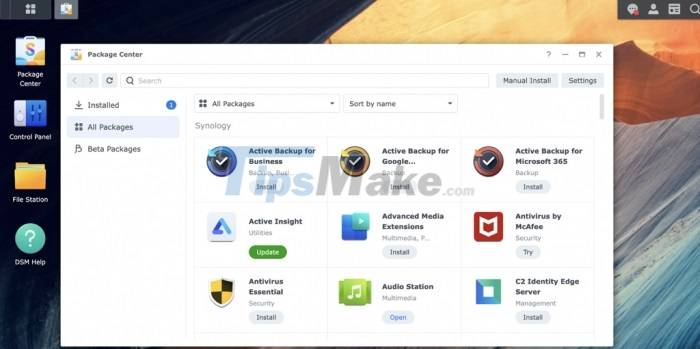 Instructions to install NAS DS1621+ as a file server for businesses Picture 39
Instructions to install NAS DS1621+ as a file server for businesses Picture 39
Step 1: Access the website interface of your NAS device, click the Package Center icon.
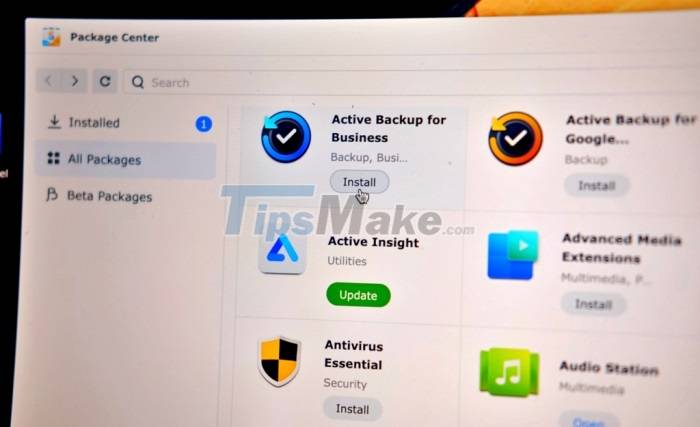 Instructions to install NAS DS1621+ as a file server for businesses Picture 40
Instructions to install NAS DS1621+ as a file server for businesses Picture 40
Step 2: In the All Packages section on the left side of the screen, you can select the applications you want, search by topic, or type in the Search box and search for that application keyword. The right side is the application store of Synology NAS, the applications with the Open symbol are installed, Install is the application that has not been downloaded and Try is a paid application, users can try it before uploading. purchase decision.
Step 3: To download, you can click Install.
When the installation is successful, the application will appear on the NAS application bar.
Uninstall the application from the Synology NAS device.
Step 1: Open Package Center > Select the installed application.
Step 2: Click the Uninstall button to completely remove the application from the system.
Install mobile app for DS1621+
 Instructions to install NAS DS1621+ as a file server for businesses Picture 41
Instructions to install NAS DS1621+ as a file server for businesses Picture 41
In addition, Synology also provides many mobile applications on both iOS and Android platforms for businesses to have more options for communicating with NAS devices. Employees can easily access and share data, work in groups or many other office needs anytime, anywhere, with just a few simple steps on the mobile application or Web browser.
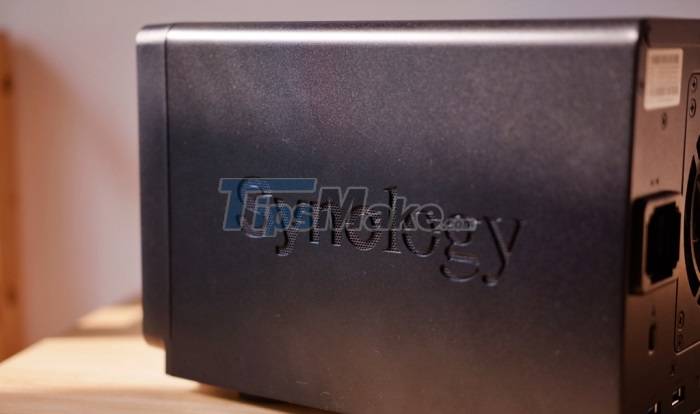 Instructions to install NAS DS1621+ as a file server for businesses Picture 42
Instructions to install NAS DS1621+ as a file server for businesses Picture 42
In the context of data "bulging" every year - Synology NAS will be a perfect choice to meet the long-term storage needs of small and medium businesses. Even businesses can expand storage in the following years easily and reduce a lot of costs incurred.
Besides, with remote access from anywhere, employees of the enterprise can collaborate and share files quickly and conveniently via web portal and mobile application. This saves a lot of time and ensures that the job is always done smoothly and seamlessly.
Synology NAS also helps protect digital assets of businesses in a comprehensive way with a full range of backup and recovery applications for PC data, file servers, virtual machines, . when unexpected problems occur. .
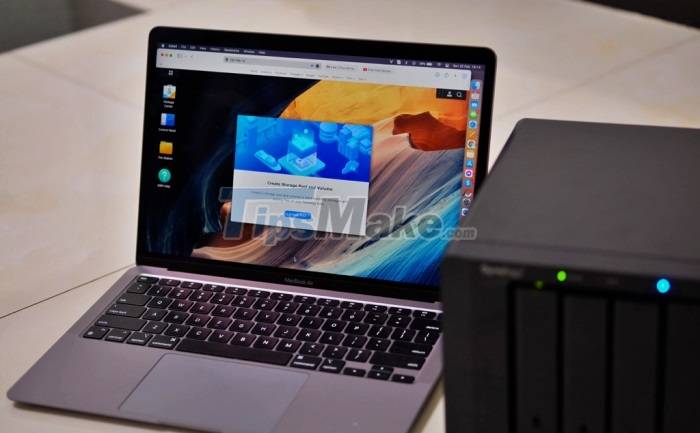 Instructions to install NAS DS1621+ as a file server for businesses Picture 43
Instructions to install NAS DS1621+ as a file server for businesses Picture 43
With a series of outstanding advantages, Synology NAS is not only an affordable centralized data storage solution, Synology also provides businesses with a huge DSM ecosystem with a wide range of applications. Useful for small and medium businesses, meeting most of the needs in work as well as entertainment.
You should read it
- Easier, smarter hard drive optimization and management with the new DSM 7.0 OS update on Synology NAS
- Not Google Drive or Windows Server, this is an effective data management solution for businesses
- Instructions for creating a Synology NAS from an old PC
- Explore the Synology DS220 + network attached storage device
- How to protect and recover data against unexpected risks?
- Synology NAS DS918 +: Powerful configuration, great scalability
- Instructions for setting up and managing FTP Server on Windows 10
- Create VPN Server on Windows 8
- 7 Enterprise Linux Server Distributions
- Instructions for setting up individual FTP Server with FileZilla
- Use IIS to set up FTP Server on Windows
- The difference between web server and app server
May be interested

Microsoft admits that hacker Lapsus$ stole the source code

BitRAT malware spreads through Windows activation software

Major IoT Security Risks of Your Smart Home; How to Deal with Them

Millions of people lined up to buy Heroic horses on the first day of DefiHorse's NFT sale

How to Successfully Access Facebook in China

How to Contact Google






 How to install and open File Server Resource Manager in Windows Server 2012
How to install and open File Server Resource Manager in Windows Server 2012 Instructions for setting up individual FTP Server with FileZilla
Instructions for setting up individual FTP Server with FileZilla Instructions for installing SQL Server 2017 step by step
Instructions for installing SQL Server 2017 step by step Steps to install Microsoft SQL Server on Windows 10
Steps to install Microsoft SQL Server on Windows 10 Instructions for installing SQL Server 2019
Instructions for installing SQL Server 2019 Instructions for installing MS SQL Server
Instructions for installing MS SQL Server